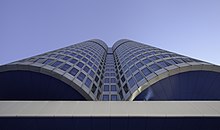BMW Headquarters

Concept and construction
The tower was built between 1968 and 1972, and it was ready in time for the 1972 Summer Olympics. The inauguration followed on 18 May 1973. The 101-metre (331 ft) building is located next to the Olympiapark and BMW's main factory. The tower's exterior is supposed to mimic the shape of four cylinders in a car engine, with the Museum building representing a cylinder head. Both buildings were designed by the Austrian architect Karl Schwanzer.
The tower consists of four vertical cylinders standing next to and across from each other. Each cylinder is divided horizontally in its center by a mold in the facade. Notably, these cylinders do not stand on the ground; they are suspended on a central support tower. During construction, individual floors were assembled on the ground and then elevated. The tower has a diameter of 52.30 metres (171.6 ft) and has 22 occupied floors, two of which are basements and 18 of which serve as office space.
BMW campus
The BMW Museum is located right next to the tower while BMW Welt, which showcases the current cars of BMW and acts as a distribution centre, opened on the opposite side of the road on 17 October 2007.
-
Aerial photograph of the BMW campus
-
Full elevation of the tower and BMW Museum
Popular culture
During the 1972 Summer Olympics, BMW branding was removed from the buildings to prevent product placement. BMW badging was also removed from the 2002 sedans, which accompanied Olympic marathon runners during the competition. The branding was removed again for the building's cameo appearance in the 1975 film Rollerball, replaced by large orange circles, meant to stand for the fictional ruling Energy Corporation of the future.
The building also made an appearance in the 1977 horror film Suspiria.
See also
References
- ^ "Emporis building ID 109463". Emporis. Archived from the original on March 7, 2016.
- ^ "BMW Headquarters". SkyscraperPage.
- ^ BMW Headquarters at Structurae
- ^ Karl Schwanzer at archINFORM


